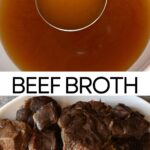This post may contain affiliate links. Please read our disclosure policy.
How to make beef broth without bones. This light, fragrant, savory, meaty homemade beef broth is ready in 2 hours either on the stove or in a crock pot – perfect for use within soups and stews, for cooking grains, and more!
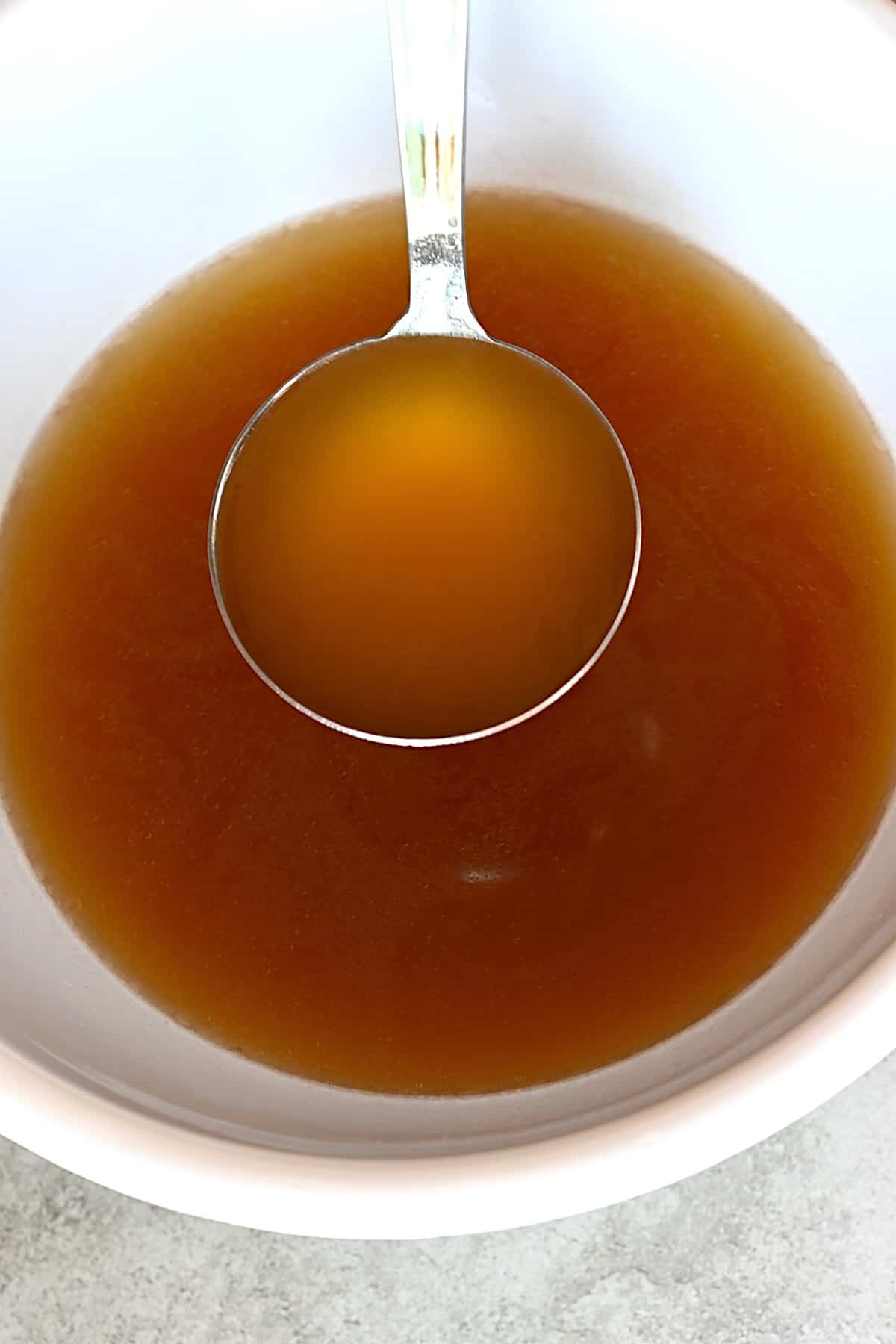
When it comes to homemade vs. store-bought, I’ll admit some recipes simply aren’t worth the time and effort. Homemade broths and stocks are NOT on that list. A well-made vegetable, chicken, or beef broth can be in a league of its own compared to store-bought versions and really takes a dish to the next level.
Sure, it takes time to brown the meat, then simmer it in water with vegetables, herbs, and spices. But you’re able to experiment with add-ins and have full control over sodium levels. Plus, it’s fairly frugal and you can make a massive batch to freeze for months of usage. So what’s the downside, really?
And since we’ll be making broth without bones, you’ll not only end up with delicious broth but also plenty of super tender meat ready to add to other recipes. If you’d rather make rich beef bone broth (beef stock), I have a recipe for that, too!
What’s in This Post
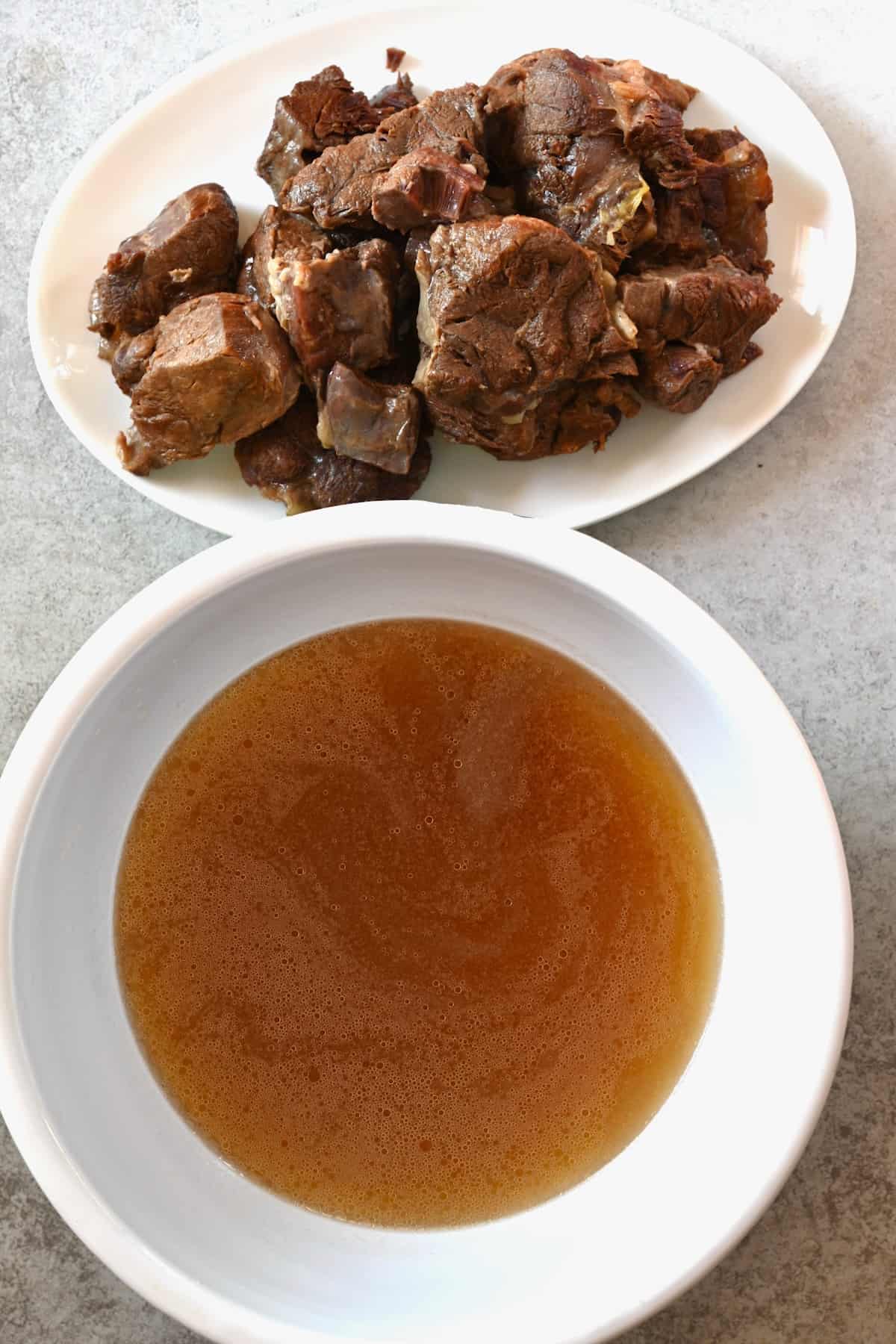
Beef Broth Vs Beef Bouillon
When referring to bouillon, two things come to mind. First, bouillon is actually the word for broth in French, and thus the two are identical, just with different names. However, we’ve also come to refer to condensed and dehydrated broth/stock as bouillon cubes, bouillon powder, and bouillon paste – all of which are highly condensed and usually packed with sodium.
Is Beef Broth the Same as Beef Consomme
While the two are similar, beef consommé is a concentrated and refined version of beef broth (or stock). It usually uses egg whites or something similar to help remove impurities from the liquid, so it’s clearer.
Is Beef Broth Good for You
This beef broth recipe might not contain as many nutrients as the stock made with bones. Yet, it is delicious, healthy, and a good source of hydration when made at home. Especially since you have control over the soduim levels and what goes in it.
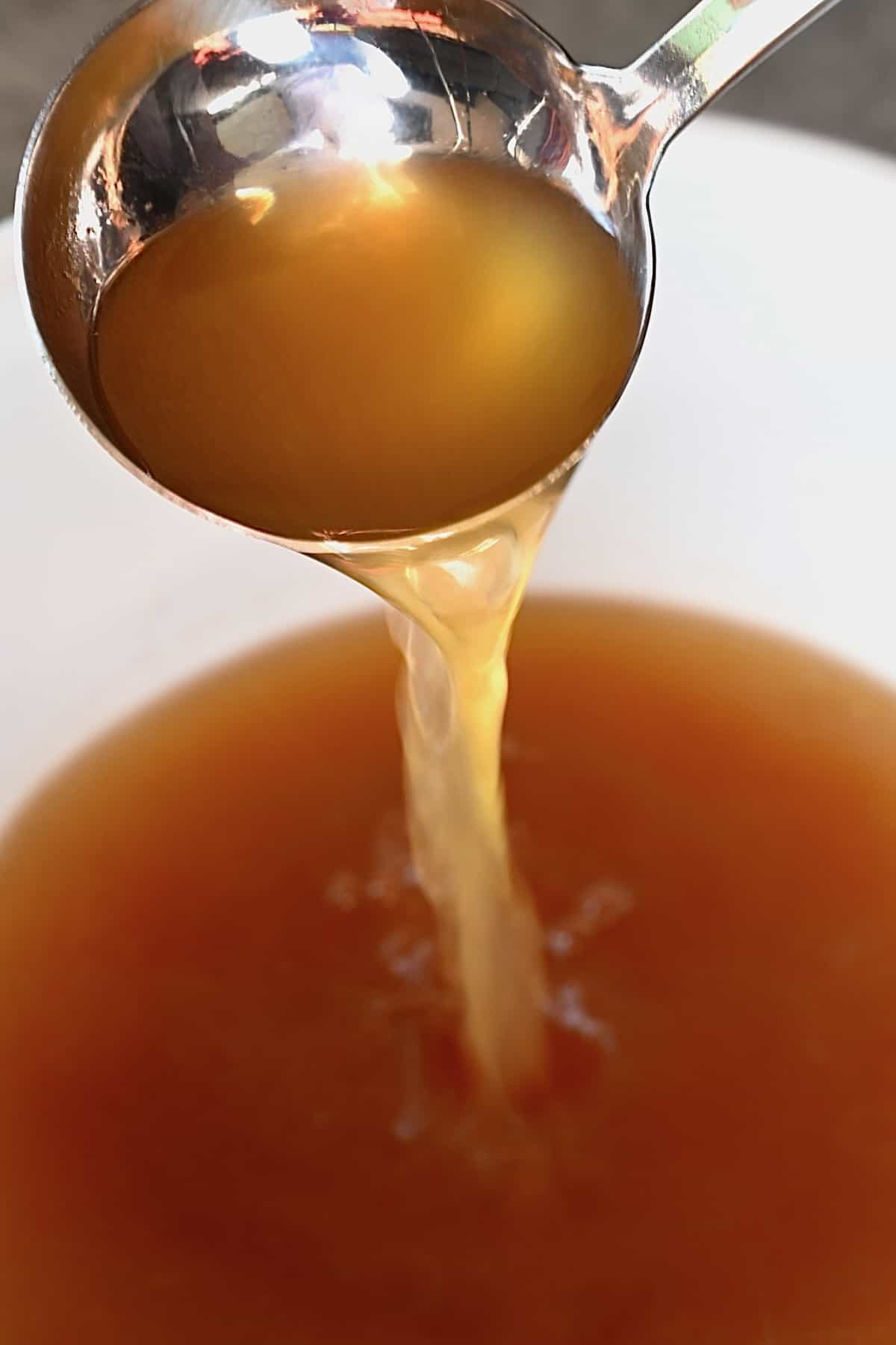
Substitute for Beef Broth
While it depends on what you plan to use it for, there are several ingredients you could use as an alternative to beef broth. These include beef stock, beef consommé, beef bouillon, chicken broth or stock, vegetable stock, mushroom broth, or even an ingredient like soy sauce or white or red wine works in some places.
The Broth Ingredients
The best broth doesn’t require a million ingredients.
- Beef: I like to use grass-fed, tough, lean beef like chuck roast. Keep reading below for other best cuts.
- Oil: Use a neutral oil to help brown the beef (which adds a ton of flavor) before preparing the homemade broth.
- Onion: I prefer to use yellow onions. They add lots of extra aromatic flavor.
- Herbs/Spices: To create more of a full-bodied broth, I use:
- Fresh ginger (optional),
- Bay leaves,
- Cinnamon stick,
- Cloves,
- Cardamom pods,
- Whole black peppercorns,
- Sea salt (optional; or soy sauce for more umami flavor and darker color).
- Water: To make up the base of the broth.
All you need for a basic beef broth recipe is bay leaves, salt, and pepper.
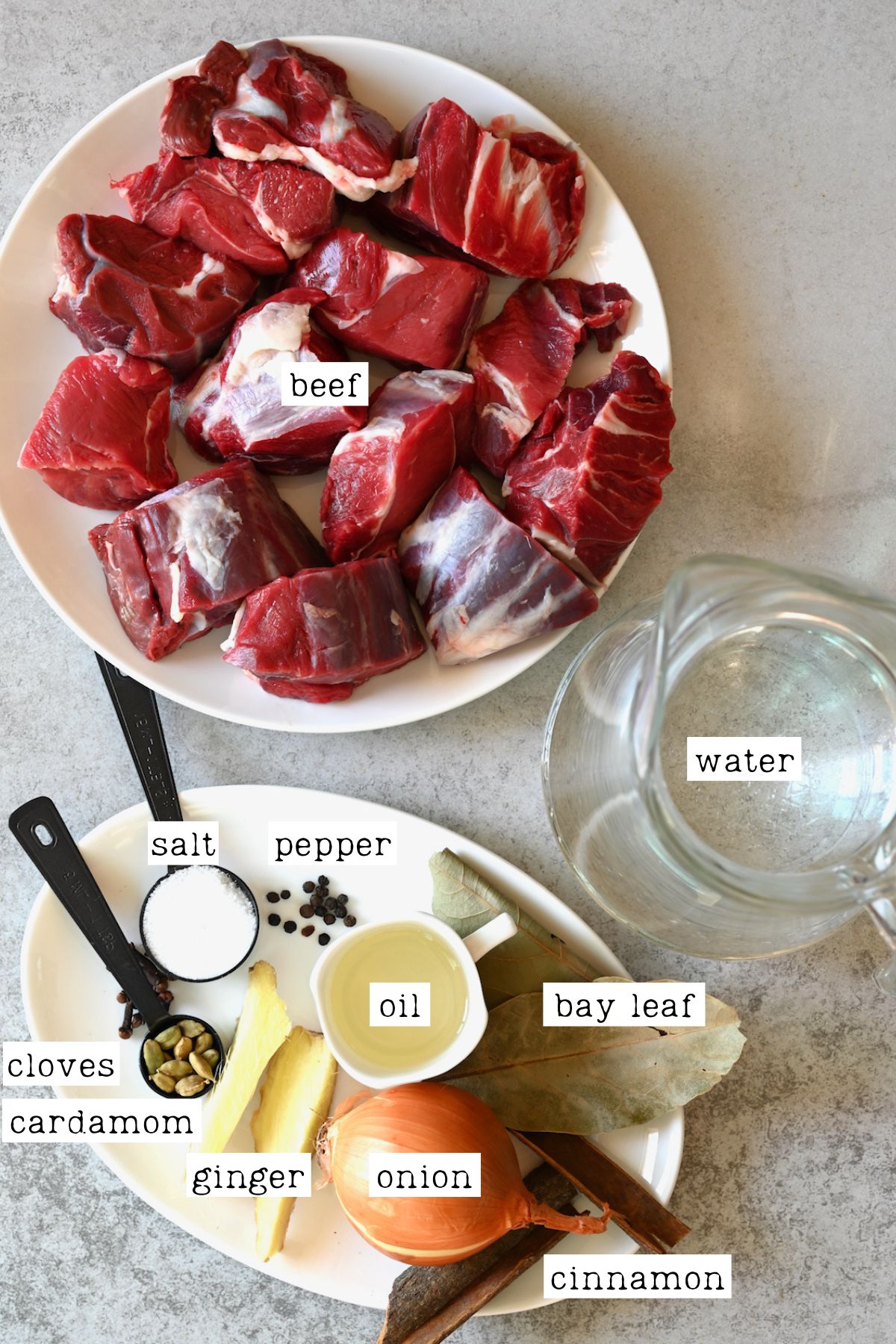
What Cut of Beef Is Best for Beef Broth?
Several types of beef cuts work particularly well for this beef broth recipe:
- Chuck roast,
- Beef shank,
- Beef short rib,
- Beef skirt,
Cuts like beef chuck are low-budget, tough cut. Yet when simmered slowly, the collagen and connective tissues within the meat will break down into gelatin for a richer, thicker broth and super tender meat great for adding to soups, stews, shredding, etc.
How to Make Beef Broth (Without Bones)
Making beef broth from scratch is a simple process and requires just a few simple steps and about two hours of your time (most of which is hands-off).
First, peel and halve the onion and, if necessary, roughly chop the beef. Then heat the oil in a heavy-based, large stock pot or Dutch oven over medium heat.
Once hot, add the beef and let it sear on all sides until browned.
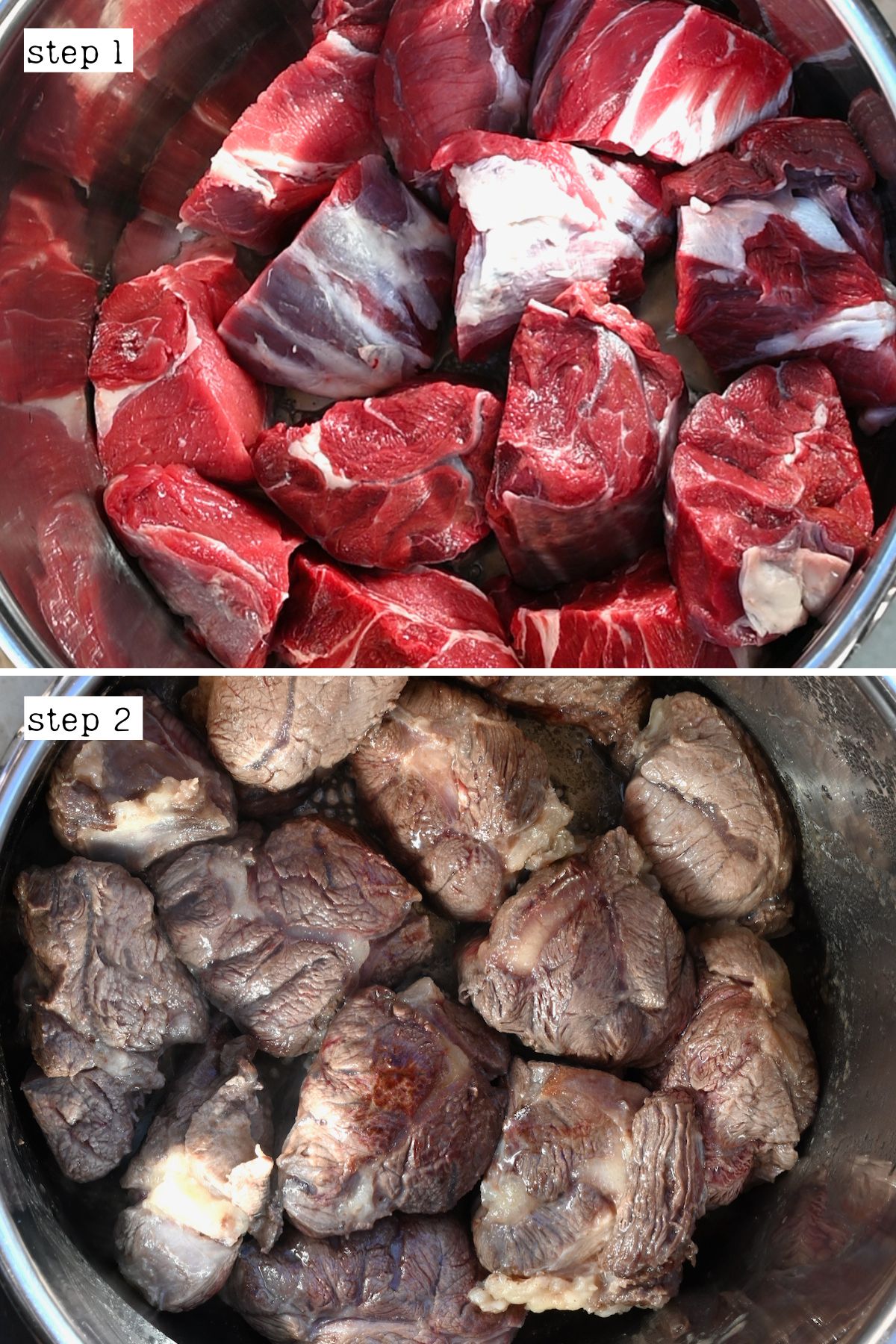
Then, pour in a little water and use your spoon/spatula to scrape up any brown bits from the bottom of the pan. Add the other ingredients and the remaining cold water (just enough to cover the beef), and bring to a boil over medium-low heat.
Boil the broth for about 30 minutes. Use a spoon or skimmer to remove any foamy scum that appears at the top of the liquid (these are impurities, and removing them makes a clearer broth).
Then, reduce the heat to low and gently simmer the broth for 1 ½ hours or until the beef is tender.
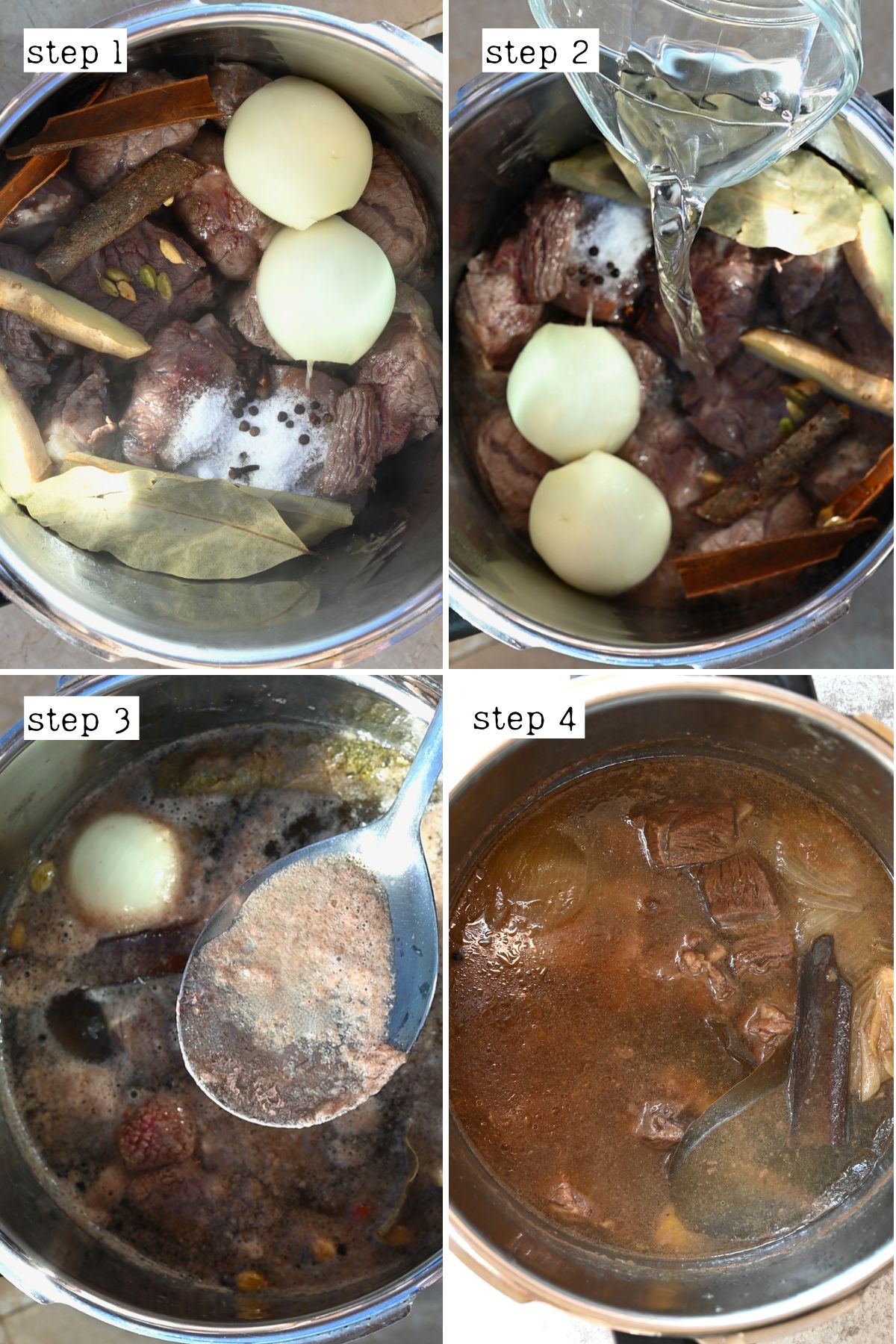
Once ready, remove the meat chunks from the broth and strain the liquid through a fine-mesh strainer. Taste and adjust the salt level, if preferred.
How to Make Condensed Beef Broth
After removing the meat and straining the liquid, return it to the stock pot and continue to simmer it until it reduces to your desired results (I usually do mine by half, making it easier to store, too).
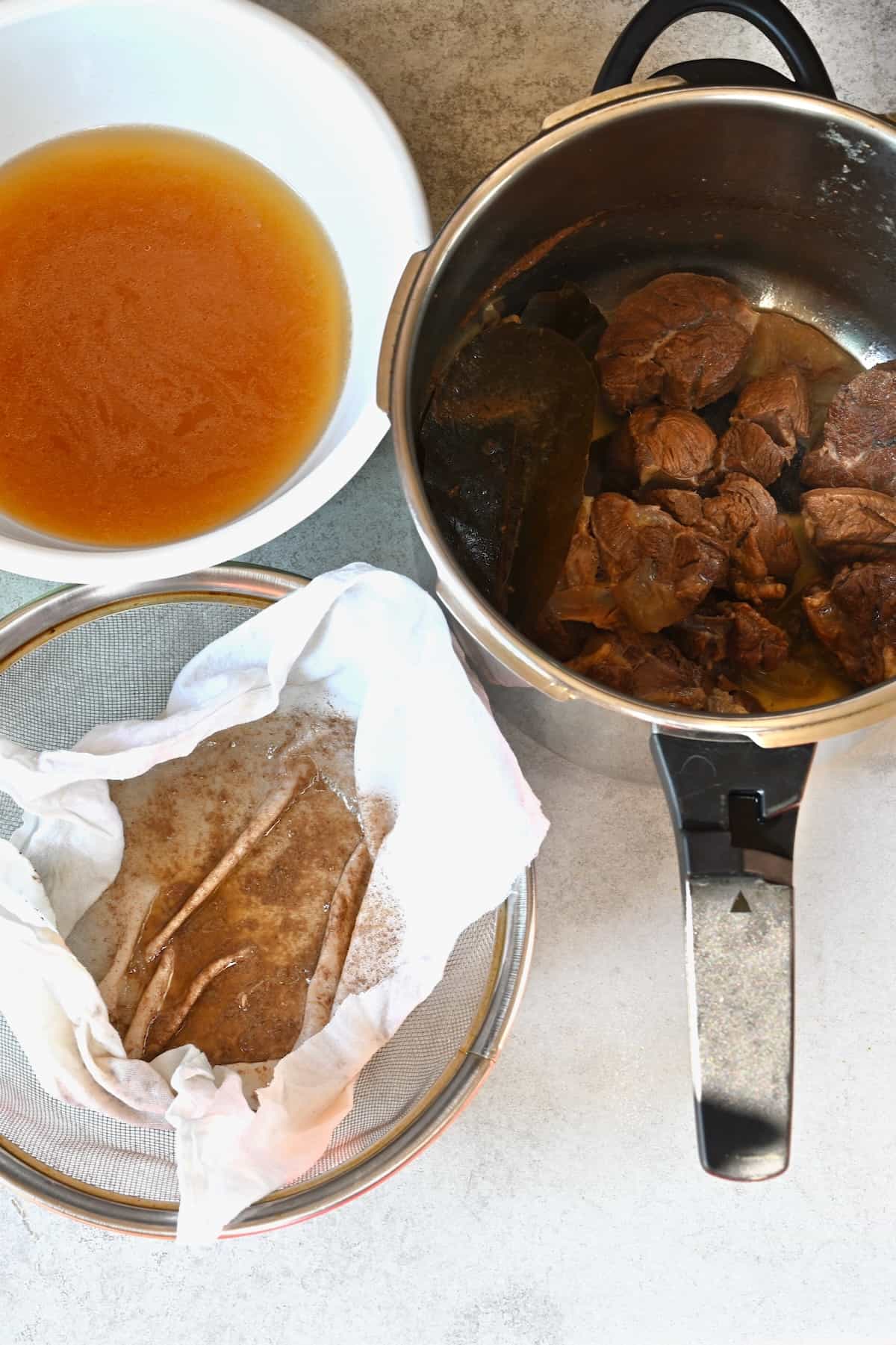
How Long Does Beef Broth Last in the Fridge
Once cooled and stored in an airtight container, it should last 5-6 days in the fridge.
It’s best to get the broth into the fridge within 2 hours of making it, though even sooner is better. Placing the container of broth in an ice bath can help to cool it down quickly.
Once chilled, you may see a layer of fat solidify at the top – this will help keep germs out and can just be lifted out of the way. However, remove it (and use it as cooking fat) if you plan to freeze the broth.
Recipes with Beef Broth
Here are just a few of many beef broth uses and recipes using beef broth:
- Slow Cooker Beef Stew Recipe,
- Beef Birria and Birria Tacos,
- Au Jus With or Without Drippings,
- To make beef broth soups – like delicious ramen, Vietnamese Pho, or egg drop soup,
- In casseroles,
- For cooking grains and pulses to add more flavor,
- To cook polenta or savory oatmeal.
It can also help to add flavor to sauces, gravies, etc.
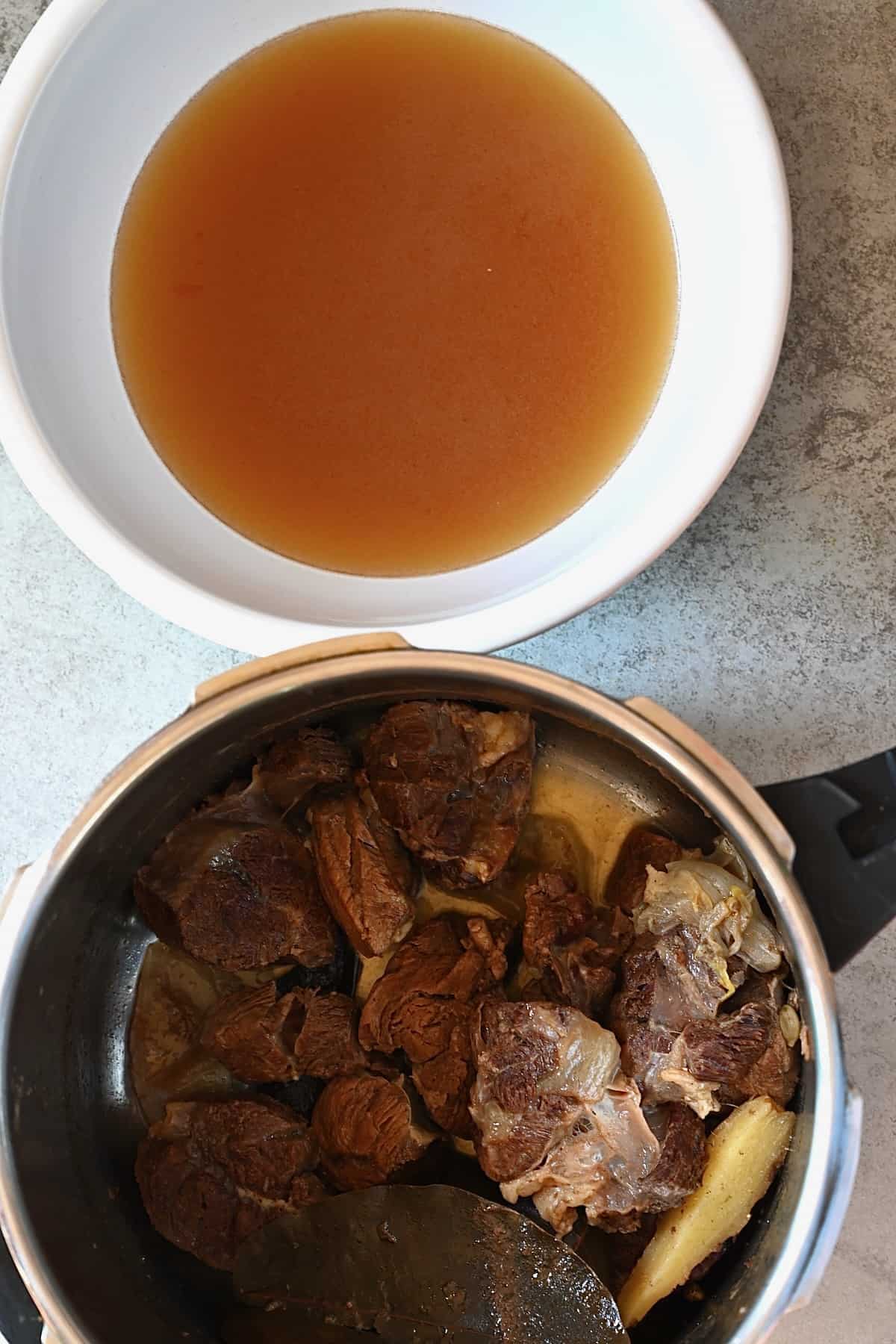
FAQs
I simmer my beef broth enough to fully cook the beef pieces (around two hours usually). To further concentrate the broth, remove the tender cooked meat and continue to simmer.
I like to use beef cuts I know will cook within the time I’m simmering the broth, so nothing goes to waste. As lots of flavor is lost in the broth, the leftover meat works best in flavorful dishes and as a “secondary flavor.”
Sauté the beef in a skillet first. Then add all the ingredients to the crockpot and cook on LOW for 8-10 hours.
More Beef Recipes
- The Best Ground Beef Taco Recipe
- Instant Pot Corned Beef and Cabbage
- Homemade Corned Beef Hash
- The Best French Dip Sandwich
- Authentic Philly Cheesesteak Sandwich

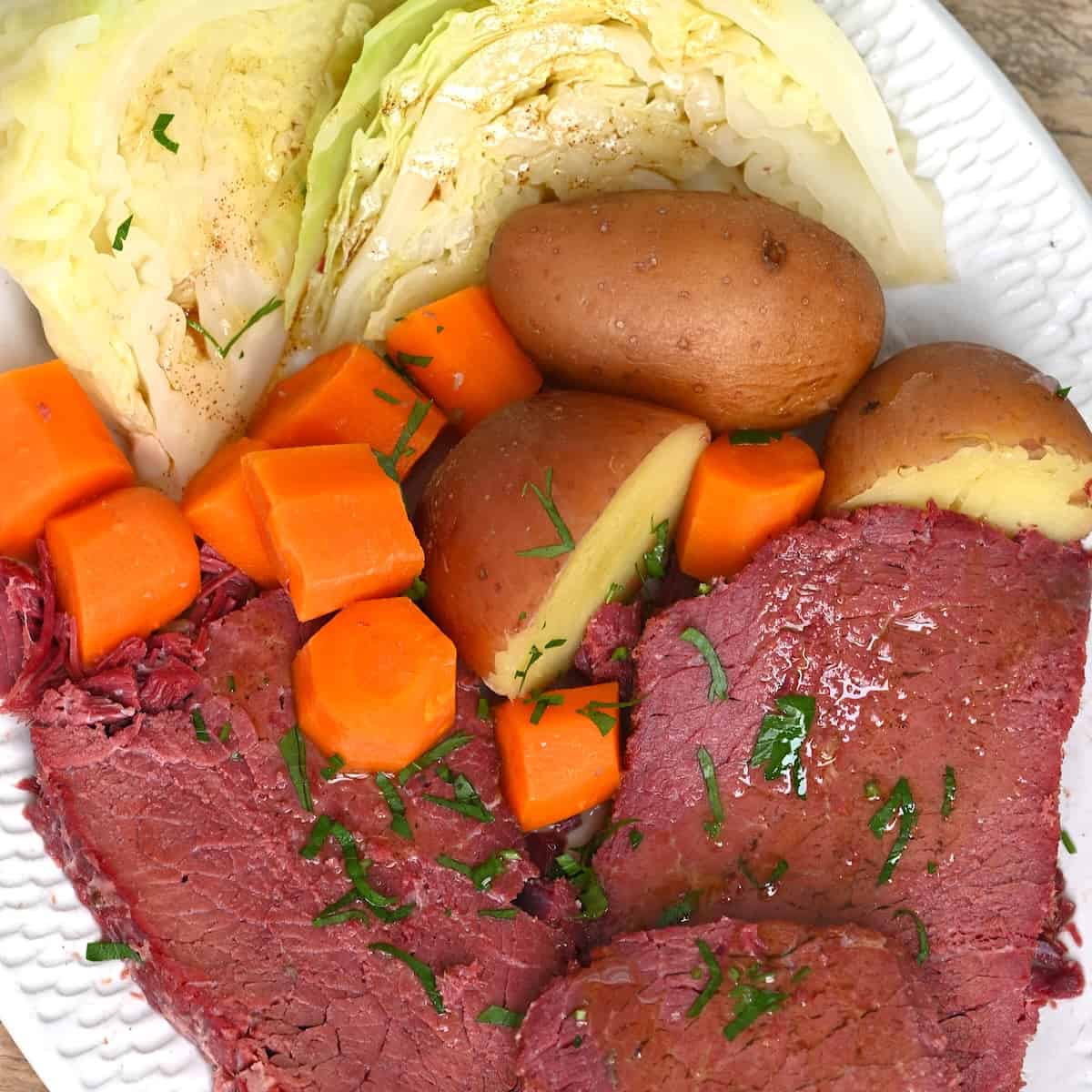
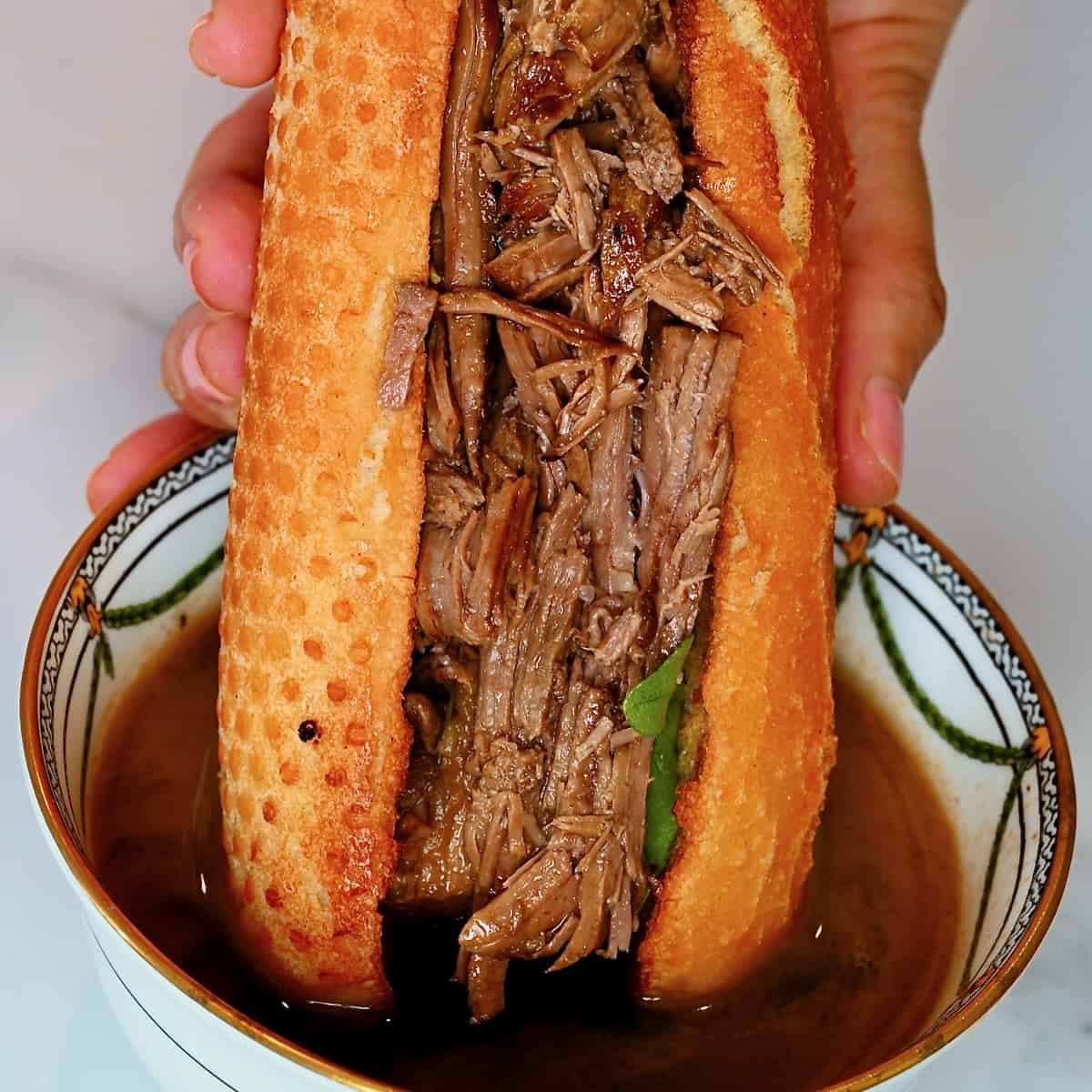
If you try this homemade broth recipe, let me know how it goes in the comments below. I’d appreciate a recipe card rating and would love to see your recipe recreations – tag me on Instagram @Alphafoodie!
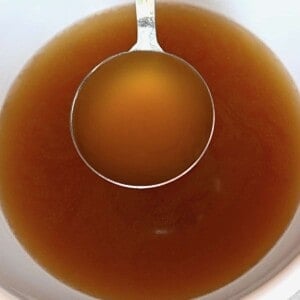
Homemade Beef Broth (Without Bones)
Ingredients
- 40 oz beef meat use tough cuts like chuck roast, beef shank, and beef skirt
- 6 cups water
- 2 Tbsp vegetable oil or another neutral oil
- 4.5 oz onion
- 2 bay leaves
- 1 Tbsp salt adjust amount to taste or leave unsalted
- 1/2 tsp whole black peppercorns
- 1 oz ginger optional
- 0.35 oz cinnamon stick optional
- 10 cloves optional
- 1 tsp cardamom pods optional
This will yield ~4 cups broth
Instructions
- Peel and halve the onion and, if necessary, roughly chop the beef.
- Heat the oil in a large, heavy-based stock pot or Dutch oven over medium heat. Once hot, add the beef and let it sear on all sides until browned.
- Pour in a little water and use a spoon/spatula to scrape up any brown bits from the bottom of the pan. Add the rest of the ingredients and remaining water (just enough to cover the beef), and bring the mixture to a boil over medium-low heat.
- Boil the beef broth for about 30 minutes. Use a spoon or skimmer to remove any foamy scum that appears at the top of the liquid (these are impurities, and removing them makes a clearer broth).
- Reduce the heat to low and simmer the broth for 1 ½ hours or until the beef is tender.
- Once ready, remove the beef pieces from the broth and strain the liquid through a fine-mesh strainer. Taste and adjust the salt level, if preferred.
How To Make Condensed Beef Broth
- After removing the meat and straining the liquid, return it to the stock pot and continue to simmer it until it reduces to your desired results (I usually do mine by half, making it easier to store, too).
Storage Instructions
- Fridge: Once cooled and stored in an airtight container, it should last 5-6 days in the fridge.Once chilled, you may see a layer of fat solidify at the top – this will help keep germs out and can just be lifted out of the way. However, remove it if you plan to freeze the broth. Freezer: Pour the cooled beef broth into several freezer-safe jars, leaving 1-inch headspace (for expansion as it freezes) OR in an XL ice-cube tray to freeze, then transfer the broth cubes to Ziplock. Store it in the freezer for 3 months. Allow it to thaw in the fridge overnight before reheating. Reheat: Use the stove top or microwave to reheat the broth gently until piping hot.
Notes
- Always brown the meat: The caramelized flavor it adds to the meat will infuse into the broth for a much richer, more delicious final product.
- Remove the meat once it’s cooked: To avoid wasting the meat, remove the beef once cooked. If you want a stronger broth, continue to simmer it until it reduces for a stronger, more concentrated stock flavor.
- Experiment with flavorings: I.e., veggies, herbs, spices, etc. I recommend making notes every time you add new ingredients/change ratios of veggies, herbs, etc. That way, you’ll be able to replicate your favorite versions easily.
- Adjust salt levels: You can leave the broth entirely unsalted to season dishes individually or salt it to your liking. If you plan to concentrate the liquid, only add a small amount of salt to begin and add more after concentrating it so you don’t accidentally over-salt it.
- Save the fat: After chilling the broth in the fridge, you may notice a layer of solidified fat on the top. Feel free to scoop this away and use it as cooking fat.
- Celery,
- Leeks,
- Parsnips,
- Carrots,
- Fresh thyme,
- fresh parsley,
- Garlic,
- Some people also like to give the flavor a bit of a “head start” by adding a small amount of beef bouillon/beef base. I usually don’t, though, to avoid excess sodium.
Nutrition
Nutrition information is automatically calculated, so should only be used as an approximation.

